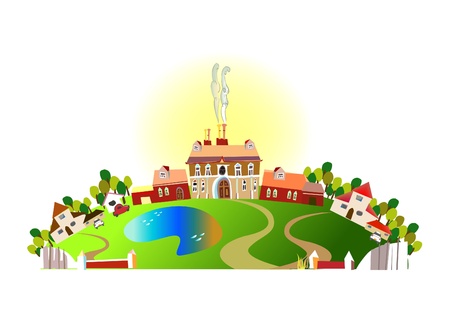Understanding Cottage Garden Aesthetics
Cottage gardens have long held a special place in the British imagination, evoking images of winding paths, riotous blooms, and an inviting sense of homeliness. Rooted in centuries-old rural tradition, the quintessential British cottage garden is defined by its informal design and abundant planting. Unlike formal gardens with rigid lines and manicured lawns, the charm of the cottage style lies in its relaxed, unstructured layout. Here, plants are encouraged to tumble over borders, mingle freely, and create a tapestry of colour and texture throughout the seasons. Layering is fundamental: tall foxgloves and hollyhocks rise at the back, while fragrant roses, lavender, and hardy perennials fill in the middle and foreground. This layered planting not only maximises visual interest but also fosters biodiversity by attracting pollinators. The welcoming atmosphere is another hallmark—garden gates often left ajar, meandering stone paths inviting visitors to wander, and seating areas nestled among blooms for moments of quiet reflection. At its heart, the British cottage garden celebrates resourcefulness, seasonality, and an enduring connection to nature—qualities that can be beautifully reimagined in even the smallest urban yards.
Planning Your Urban Retreat
Before you start adding quintessentially British cottage garden touches to your small urban yard, a well-considered plan is essential. Assessing your space thoroughly ensures that every inch works hard to evoke charm and comfort, despite the city’s constraints. Begin by evaluating three core factors: light, soil, and local climate.
Assessing Key Elements
| Element | Considerations | Tips for Urban Gardens |
|---|---|---|
| Light | Observe sunlight patterns throughout the day; note areas of full sun, partial shade, or deep shade. | Choose plants suited to each microclimate. For example, foxgloves thrive in dappled shade, while lavender needs full sun. |
| Soil | Test for drainage and fertility; urban soils may be compacted or depleted. | Add organic matter or use raised beds to improve structure and nutrients, reflecting the lushness of classic cottage gardens. |
| Climate | Consider local temperature ranges, rainfall, and exposure to wind. | Select hardy plants that can withstand city conditions. Seek varieties traditionally grown in UK cottage gardens but adapted to your locale. |
Setting Realistic Cottage Garden Goals
Your vision may include winding paths, vibrant perennial borders, or even a secluded seating nook. However, it’s important to set goals that fit both your available space and maintenance capacity. In a small urban garden, focus on layering planting heights, mixing textures, and incorporating vertical elements like trellises for climbers—classic features of British cottage gardens condensed into a manageable scale.
Urban Constraints vs Cottage Charm: Finding Balance
| Cottage Garden Feature | Urban Adaptation |
|---|---|
| Expansive flower borders | Narrow mixed borders against fences or walls |
| Mature trees and shrubs | Dwarf varieties or espaliered fruit trees along boundaries |
| Rambling roses over arbours | Climbing roses on wall-mounted trellises |
| Lawn pathways winding through planting | Paved stepping stones or gravel paths with edging plants |
Action Steps:
1. Map out sunlight exposure at different times of day.
2. Conduct a simple soil test and amend as needed.
3. List key features you wish to include—prioritise those which offer maximum charm within minimal space.
4. Research plant varieties proven in UK urban environments.
With thoughtful planning and realistic expectations, you will lay the groundwork for a truly cosy cottage-inspired retreat—even in the heart of the city.

3. Selecting Classic Plants for Year-Round Interest
Creating a quintessential cottage garden in your small urban yard begins with choosing the right plants—those that not only thrive in British climates but also provide enduring beauty and charm throughout the year. To achieve this, focus on time-honoured, low-maintenance favourites that have graced UK gardens for generations.
Foxgloves: Iconic Spires of Colour
Foxgloves (Digitalis purpurea) are a staple in any traditional cottage garden. Their tall, elegant spires burst into bloom from late spring to early summer, attracting bees and adding vertical interest to even the smallest plots. Opt for mixed varieties to enjoy a palette of soft pinks, purples, and creams that blend seamlessly with other perennials.
Lavender: Scent and Structure
No cottage garden is complete without the soothing scent and silvery foliage of lavender. Hardy English varieties such as Lavandula angustifolia flourish in well-drained soils and sunny spots. Lavender’s compact form is ideal for edging paths or framing small seating areas, providing both structure and fragrance from late spring through summer.
Geraniums: Reliable Ground Cover
Cranesbill geraniums are beloved for their resilience and ease of care. Their mounding habit fills gaps between larger specimens, suppressing weeds while offering a succession of pink, purple, or blue blooms from late spring into autumn. Many varieties also display attractive autumn foliage, ensuring continued visual interest as the seasons shift.
Additional Cottage Favourites
To enhance texture and seasonal colour, consider interplanting classic choices such as delphiniums, hardy roses, and alliums. These traditional plants not only echo the romantic spirit of English gardens but also provide habitats for pollinators—a vital consideration in urban settings.
Planning for Year-Round Appeal
By thoughtfully combining these time-tested British plants, you’ll ensure that your urban retreat remains vibrant and inviting across the seasons. Select species that offer overlapping flowering times and varied leaf textures to create layers of interest, transforming your small city space into an ever-changing haven inspired by countryside tradition.
4. Creating Layers and Structure
To achieve authentic cottage garden charm in a small urban yard, establishing layers and structure is essential. This involves thoughtful planning of planting borders, integrating climbers and hedges, and defining spaces with pathways or rustic materials—all while preserving the inviting, informal atmosphere characteristic of traditional British cottage gardens.
Arranging Planting Borders
Begin by designing your borders with a relaxed, slightly untamed look. Place taller plants such as hollyhocks, foxgloves, or delphiniums at the back or centre if your bed is island-style. Middle layers can include classic perennials like lupins and geraniums, while low-growing herbs or groundcovers such as thyme, lady’s mantle, or violas soften the front edge. The goal is to mimic nature’s layering—abundant but not rigidly structured.
Suggested Planting Border Arrangement
| Layer | Suggested Plants | Visual Effect |
|---|---|---|
| Back/Vertical Layer | Hollyhock, Delphinium, Climbing Rose | Height & drama against fences/walls |
| Middle Layer | Lupin, Foxglove, Geranium | Colourful fullness & seasonal interest |
| Front/Edge Layer | Thyme, Lady’s Mantle, Viola | Softened borders & fragrance underfoot |
Integrating Climbers and Hedges
Vertical elements are key for small spaces. Choose climbers like sweet peas, clematis, or wisteria to train up trellises, arches, or even drainpipes—adding height without taking up precious ground space. Traditional hedging plants such as boxwood or lavender can be used to subtly divide areas while adding structure and evergreen interest. For a softer effect, use woven willow hurdles or loose hazel fencing as alternatives to hard landscaping.
Climbers & Hedges: Practical Considerations
| Element | Best Use in Small Urban Yards | Cottage Garden Tip |
|---|---|---|
| Clematis/Sweet Pea | Walls, archways, vertical screens | Select varieties with long flowering periods for extended colour |
| Boxwood/Lavender Hedge | Low boundary definition; dividing zones e.g., seating vs planting areas | Lavender provides scent and attracts pollinators; boxwood offers year-round formality beneath informality of flowers |
| Willow/Hazel Fencing | Create rustic divisions that blend into planting schemes | Easily repositioned for flexible garden layout changes as your needs evolve |
Defining Spaces with Pathways and Rustic Materials
Cottage gardens often feature winding paths that encourage exploration. In an urban setting, use reclaimed brick, gravel, stepping stones or bark chips to create meandering walkways between beds and seating areas. These materials echo rural sensibilities while being practical for small plots. Edging pathways with low herbs or self-seeders enhances the sense of abundance without feeling overcrowded.
Cottage Garden Pathway Materials: Pros & Cons Table
| Material | Aesthetic Appeal | Main Benefit | Main Consideration |
|---|---|---|---|
| Reclaimed Brick | Traditional English feel | Durable & ages beautifully | Laying can be labour-intensive |
| Bark Chips | Natural woodland look | Soft underfoot & easy to install | Needs regular topping up |
| Gravel | Crisp yet informal edges | Good drainage; easy to reshape paths | Might shift over time with heavy use |
The interplay of layered planting, vertical accents from climbers and hedges, and organically defined pathways creates a series of intimate ‘garden rooms’ within even the smallest plot. This approach delivers both structure and the quintessentially British sense of welcoming enclosure that defines a true cottage garden retreat.
5. Incorporating Traditional Features and Touches
To truly capture the essence of a classic British cottage garden within a compact urban setting, it is essential to weave in traditional features that evoke nostalgia while remaining practical. These time-honoured elements are not only visually charming but also serve a functional purpose, making your cosy retreat both beautiful and usable.
Picket Fences: Defining Boundaries with Character
A white or pastel-painted picket fence is a quintessential feature of the English cottage garden. Even in small spaces, a low wooden fence helps demarcate your plot, provides support for climbing plants like sweet peas or roses, and adds an instant sense of quaintness. Consider using reclaimed timber for added sustainability and character.
Vintage Pots: Timeless Containers for Planting
Incorporate terracotta or weathered stone pots throughout your garden to create focal points and maximise planting opportunities. Vintage containers can be tucked into corners, atop brick walls, or grouped beside pathways. Fill them with fragrant herbs, trailing lobelia, or cheerful geraniums to evoke the informal abundance typical of cottage gardens.
Birdbaths: Welcoming Wildlife
A classic birdbath not only brings old-world charm but also encourages local birds to visit your garden, enhancing its sense of life and tranquillity. Opt for a simple stone pedestal or a decorative cast-iron bowl—both are compact enough for urban yards yet impactful in creating atmosphere.
Bespoke Seating: Inviting Restful Moments
Handcrafted benches or painted bistro sets provide inviting spots to pause and enjoy your surroundings. Look for wrought iron or slatted wooden designs that reflect traditional English tastes. Position seating beneath a flowering archway or beside a fragrant border for maximum enjoyment in limited space.
Nostalgia Meets Functionality
By thoughtfully selecting these traditional features—each chosen for its historic resonance as well as its everyday practicality—you can transform even the smallest city yard into a true cottage garden retreat. Every element adds a layer of storytelling and comfort, ensuring your outdoor space feels both rooted in heritage and tailored for modern living.
6. Encouraging Wildlife and Sustainability
One of the most enchanting aspects of a traditional cottage garden is its vibrant wildlife, from bees buzzing among the blooms to birds singing in the hedgerows. Even within a small urban yard, you can foster this lively ecosystem by making mindful choices that support biodiversity and create a sanctuary for both people and nature.
Inviting Pollinators with Native Planting
Native British species are perfectly adapted to local conditions and provide essential nourishment for pollinators such as bees, butterflies, and hoverflies. Incorporate plants like foxglove (Digitalis purpurea), cowslip (Primula veris), and common yarrow (Achillea millefolium) into your borders. These species not only thrive with minimal care but also offer nectar and pollen through much of the growing season, attracting beneficial insects that are vital for a healthy garden.
Creating Habitats for Birds
Encourage feathered visitors by planting berry-producing shrubs like hawthorn or elder, which provide food throughout autumn and winter. Dense climbers such as honeysuckle or ivy can offer shelter and nesting sites. You might also consider installing nest boxes on walls or fences in discreet spots to support garden birds such as robins, wrens, and blue tits.
Incorporating Water Features
A small pond or bird bath can become a focal point of your urban retreat while offering drinking and bathing opportunities for wildlife. Even a half-barrel pond filled with native aquatic plants supports frogs, dragonflies, and other creatures. Remember to include gently sloping sides or stones so animals can enter and exit safely.
Natural Gardening Practices
Sustainable techniques are key to maintaining both charm and ecological balance in your cottage garden. Avoid chemical pesticides; instead, encourage natural predators like ladybirds and lacewings to keep pests in check. Use homemade compost to nourish your soil, mulch beds to retain moisture, and collect rainwater where possible. By working with nature rather than against it, you’ll find your small urban space becomes richer in life each year.
Through thoughtful planting and gentle stewardship, your cosy city garden can blossom into a haven that welcomes wildlife while upholding the timeless allure of the classic British cottage retreat.
7. Seasonal Care and Practical Tips
To keep your urban cottage garden thriving in every season, a little planning and regular care make all the difference. Embracing the British climate and using practical tools will help you maintain that quintessentially cosy retreat throughout the year.
Spring: Setting the Stage
Begin with a thorough tidy-up: clear away dead stems, refresh mulches, and prune back shrubs as needed. This is also the ideal time to sow hardy annuals like sweet peas or cornflowers directly into borders for vibrant summer colour. Remember to divide overcrowded perennials and top up compost in containers for a fresh start.
Summer: Enjoyment and Upkeep
Watering becomes key during dry spells—early morning or late evening is best to avoid evaporation. Deadhead faded blooms from roses, geraniums, and other cottage favourites to encourage further flowering. Keep an eye out for pests such as aphids; a gentle spray of water or introducing ladybirds can help manage outbreaks naturally.
Autumn: Preparing for Rest
As the days shorten, tidy away spent annuals and cut back herbaceous perennials once they have finished. Collect seeds from self-seeders like foxgloves or poppies for next year’s planting. Mulch borders with well-rotted manure or leaf mould to protect roots through winter chills—a very British approach to soil care.
Winter: Maintenance and Planning
Keep paths clear of leaves to prevent slips and ensure garden structures remain sturdy in storms. Use this quieter period to service tools—sharpen shears, oil wooden handles, and check pots for frost damage. Take time indoors with a cup of tea to plan next season’s plantings; catalogues and gardening books offer plenty of inspiration for new varieties.
Essential Tools for Urban Gardeners
A few well-chosen tools make maintenance efficient: a hand fork for tight spaces, secateurs for precise pruning, a small watering can for delicate seedlings, and sturdy gloves are all invaluable in compact gardens. Consider a compost bin if space allows—it’s both sustainable and practical for urban environments.
Top Tip: Little and Often
Regular short bursts of gardening fit easily into busy city life and keep your retreat looking its best without becoming overwhelming. With each season’s tasks in mind, your cottage garden will continue to charm you—and your visitors—all year round.


